Role of Exposure Nurse in Managing a Patient with Chronic Obstructive Pulmonary Disease
VerifiedAdded on 2023/04/22
|7
|1279
|327
AI Summary
This article discusses the role of an exposure nurse in managing a patient with Chronic Obstructive Pulmonary Disease (COPD) and the importance of effective communication and problem-solving skills in nursing profession.
Contribute Materials
Your contribution can guide someone’s learning journey. Share your
documents today.
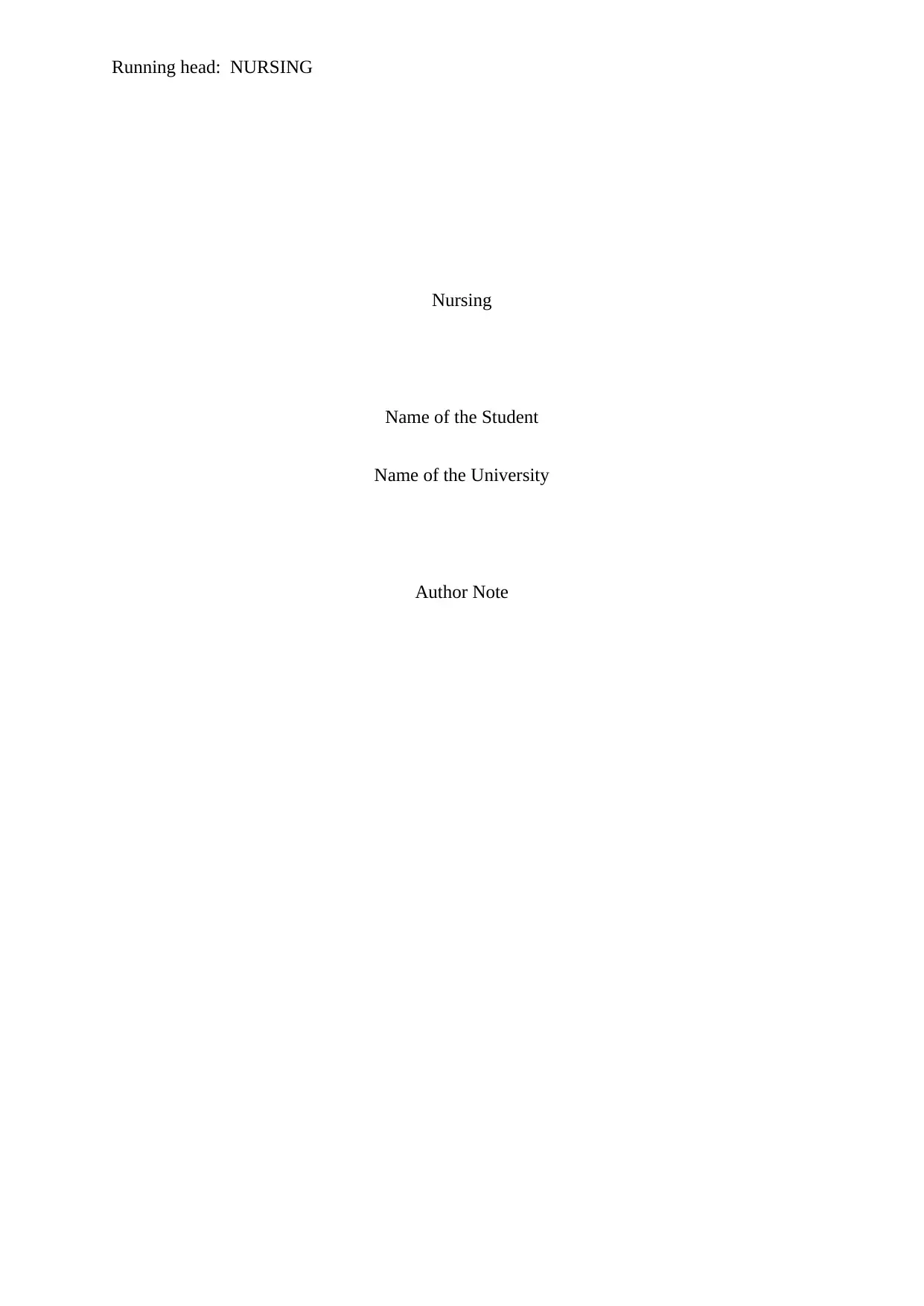
Running head: NURSING
Nursing
Name of the Student
Name of the University
Author Note
Nursing
Name of the Student
Name of the University
Author Note
Secure Best Marks with AI Grader
Need help grading? Try our AI Grader for instant feedback on your assignments.
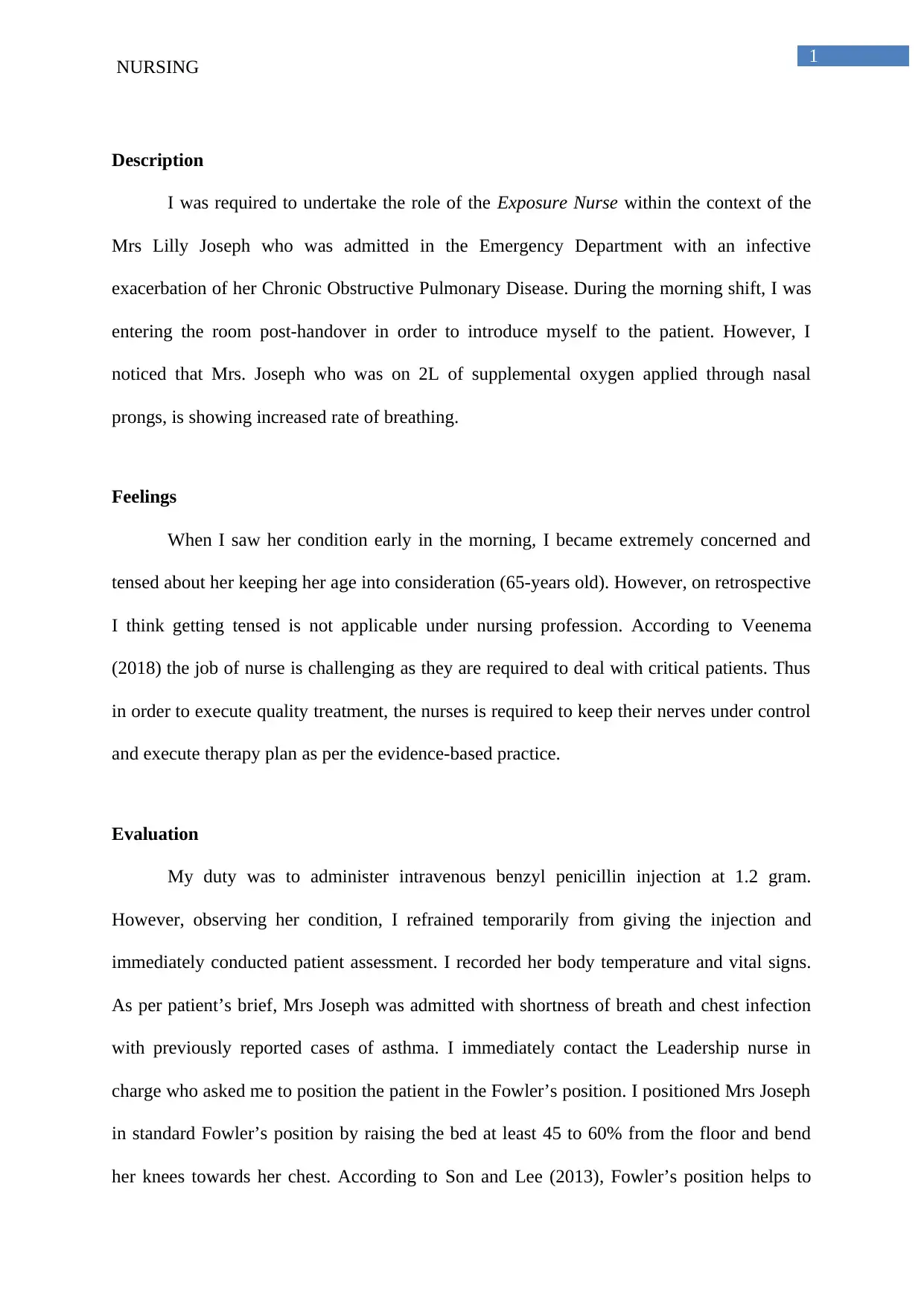
1
NURSING
Description
I was required to undertake the role of the Exposure Nurse within the context of the
Mrs Lilly Joseph who was admitted in the Emergency Department with an infective
exacerbation of her Chronic Obstructive Pulmonary Disease. During the morning shift, I was
entering the room post-handover in order to introduce myself to the patient. However, I
noticed that Mrs. Joseph who was on 2L of supplemental oxygen applied through nasal
prongs, is showing increased rate of breathing.
Feelings
When I saw her condition early in the morning, I became extremely concerned and
tensed about her keeping her age into consideration (65-years old). However, on retrospective
I think getting tensed is not applicable under nursing profession. According to Veenema
(2018) the job of nurse is challenging as they are required to deal with critical patients. Thus
in order to execute quality treatment, the nurses is required to keep their nerves under control
and execute therapy plan as per the evidence-based practice.
Evaluation
My duty was to administer intravenous benzyl penicillin injection at 1.2 gram.
However, observing her condition, I refrained temporarily from giving the injection and
immediately conducted patient assessment. I recorded her body temperature and vital signs.
As per patient’s brief, Mrs Joseph was admitted with shortness of breath and chest infection
with previously reported cases of asthma. I immediately contact the Leadership nurse in
charge who asked me to position the patient in the Fowler’s position. I positioned Mrs Joseph
in standard Fowler’s position by raising the bed at least 45 to 60% from the floor and bend
her knees towards her chest. According to Son and Lee (2013), Fowler’s position helps to
NURSING
Description
I was required to undertake the role of the Exposure Nurse within the context of the
Mrs Lilly Joseph who was admitted in the Emergency Department with an infective
exacerbation of her Chronic Obstructive Pulmonary Disease. During the morning shift, I was
entering the room post-handover in order to introduce myself to the patient. However, I
noticed that Mrs. Joseph who was on 2L of supplemental oxygen applied through nasal
prongs, is showing increased rate of breathing.
Feelings
When I saw her condition early in the morning, I became extremely concerned and
tensed about her keeping her age into consideration (65-years old). However, on retrospective
I think getting tensed is not applicable under nursing profession. According to Veenema
(2018) the job of nurse is challenging as they are required to deal with critical patients. Thus
in order to execute quality treatment, the nurses is required to keep their nerves under control
and execute therapy plan as per the evidence-based practice.
Evaluation
My duty was to administer intravenous benzyl penicillin injection at 1.2 gram.
However, observing her condition, I refrained temporarily from giving the injection and
immediately conducted patient assessment. I recorded her body temperature and vital signs.
As per patient’s brief, Mrs Joseph was admitted with shortness of breath and chest infection
with previously reported cases of asthma. I immediately contact the Leadership nurse in
charge who asked me to position the patient in the Fowler’s position. I positioned Mrs Joseph
in standard Fowler’s position by raising the bed at least 45 to 60% from the floor and bend
her knees towards her chest. According to Son and Lee (2013), Fowler’s position helps to
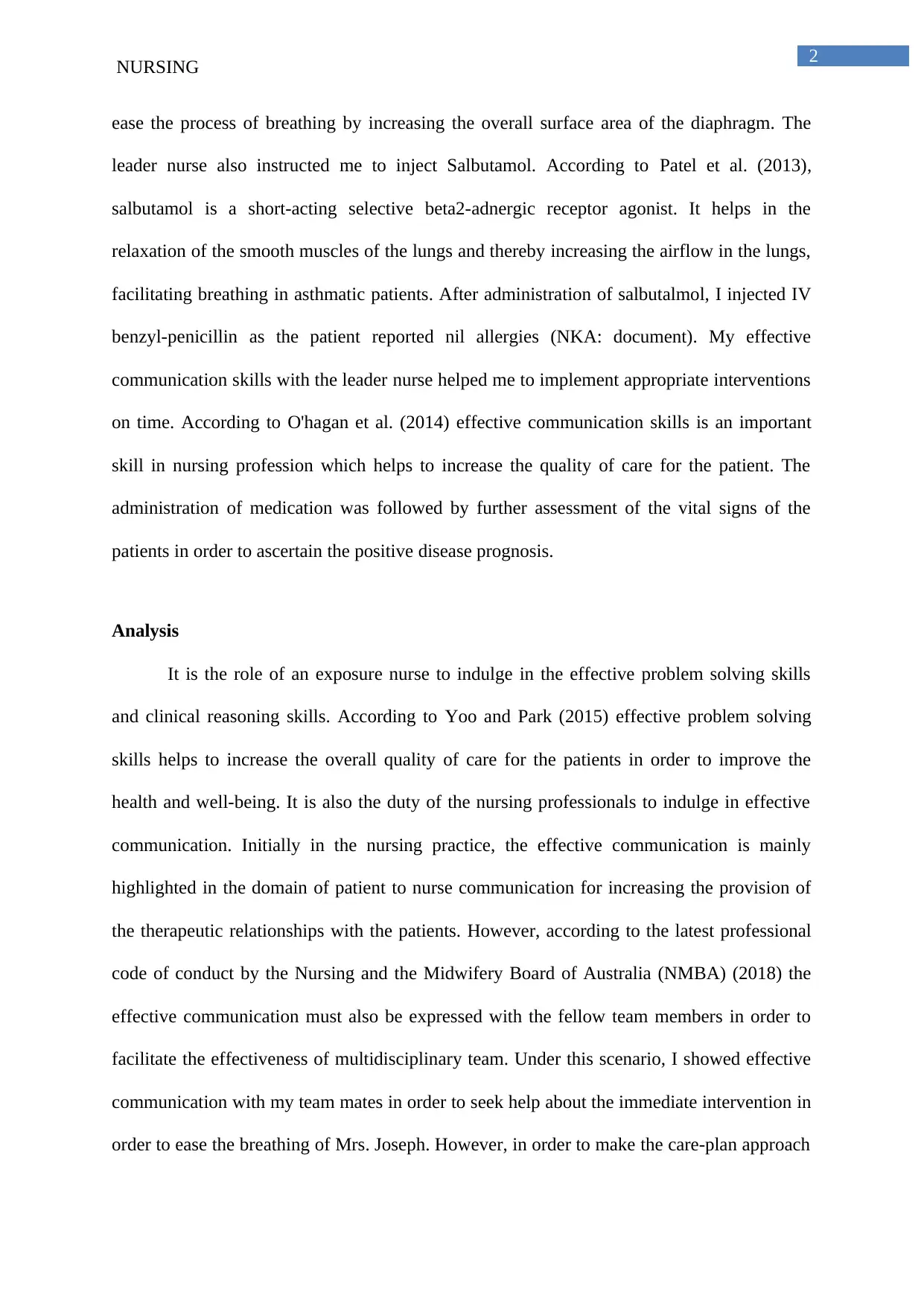
2
NURSING
ease the process of breathing by increasing the overall surface area of the diaphragm. The
leader nurse also instructed me to inject Salbutamol. According to Patel et al. (2013),
salbutamol is a short-acting selective beta2-adnergic receptor agonist. It helps in the
relaxation of the smooth muscles of the lungs and thereby increasing the airflow in the lungs,
facilitating breathing in asthmatic patients. After administration of salbutalmol, I injected IV
benzyl-penicillin as the patient reported nil allergies (NKA: document). My effective
communication skills with the leader nurse helped me to implement appropriate interventions
on time. According to O'hagan et al. (2014) effective communication skills is an important
skill in nursing profession which helps to increase the quality of care for the patient. The
administration of medication was followed by further assessment of the vital signs of the
patients in order to ascertain the positive disease prognosis.
Analysis
It is the role of an exposure nurse to indulge in the effective problem solving skills
and clinical reasoning skills. According to Yoo and Park (2015) effective problem solving
skills helps to increase the overall quality of care for the patients in order to improve the
health and well-being. It is also the duty of the nursing professionals to indulge in effective
communication. Initially in the nursing practice, the effective communication is mainly
highlighted in the domain of patient to nurse communication for increasing the provision of
the therapeutic relationships with the patients. However, according to the latest professional
code of conduct by the Nursing and the Midwifery Board of Australia (NMBA) (2018) the
effective communication must also be expressed with the fellow team members in order to
facilitate the effectiveness of multidisciplinary team. Under this scenario, I showed effective
communication with my team mates in order to seek help about the immediate intervention in
order to ease the breathing of Mrs. Joseph. However, in order to make the care-plan approach
NURSING
ease the process of breathing by increasing the overall surface area of the diaphragm. The
leader nurse also instructed me to inject Salbutamol. According to Patel et al. (2013),
salbutamol is a short-acting selective beta2-adnergic receptor agonist. It helps in the
relaxation of the smooth muscles of the lungs and thereby increasing the airflow in the lungs,
facilitating breathing in asthmatic patients. After administration of salbutalmol, I injected IV
benzyl-penicillin as the patient reported nil allergies (NKA: document). My effective
communication skills with the leader nurse helped me to implement appropriate interventions
on time. According to O'hagan et al. (2014) effective communication skills is an important
skill in nursing profession which helps to increase the quality of care for the patient. The
administration of medication was followed by further assessment of the vital signs of the
patients in order to ascertain the positive disease prognosis.
Analysis
It is the role of an exposure nurse to indulge in the effective problem solving skills
and clinical reasoning skills. According to Yoo and Park (2015) effective problem solving
skills helps to increase the overall quality of care for the patients in order to improve the
health and well-being. It is also the duty of the nursing professionals to indulge in effective
communication. Initially in the nursing practice, the effective communication is mainly
highlighted in the domain of patient to nurse communication for increasing the provision of
the therapeutic relationships with the patients. However, according to the latest professional
code of conduct by the Nursing and the Midwifery Board of Australia (NMBA) (2018) the
effective communication must also be expressed with the fellow team members in order to
facilitate the effectiveness of multidisciplinary team. Under this scenario, I showed effective
communication with my team mates in order to seek help about the immediate intervention in
order to ease the breathing of Mrs. Joseph. However, in order to make the care-plan approach
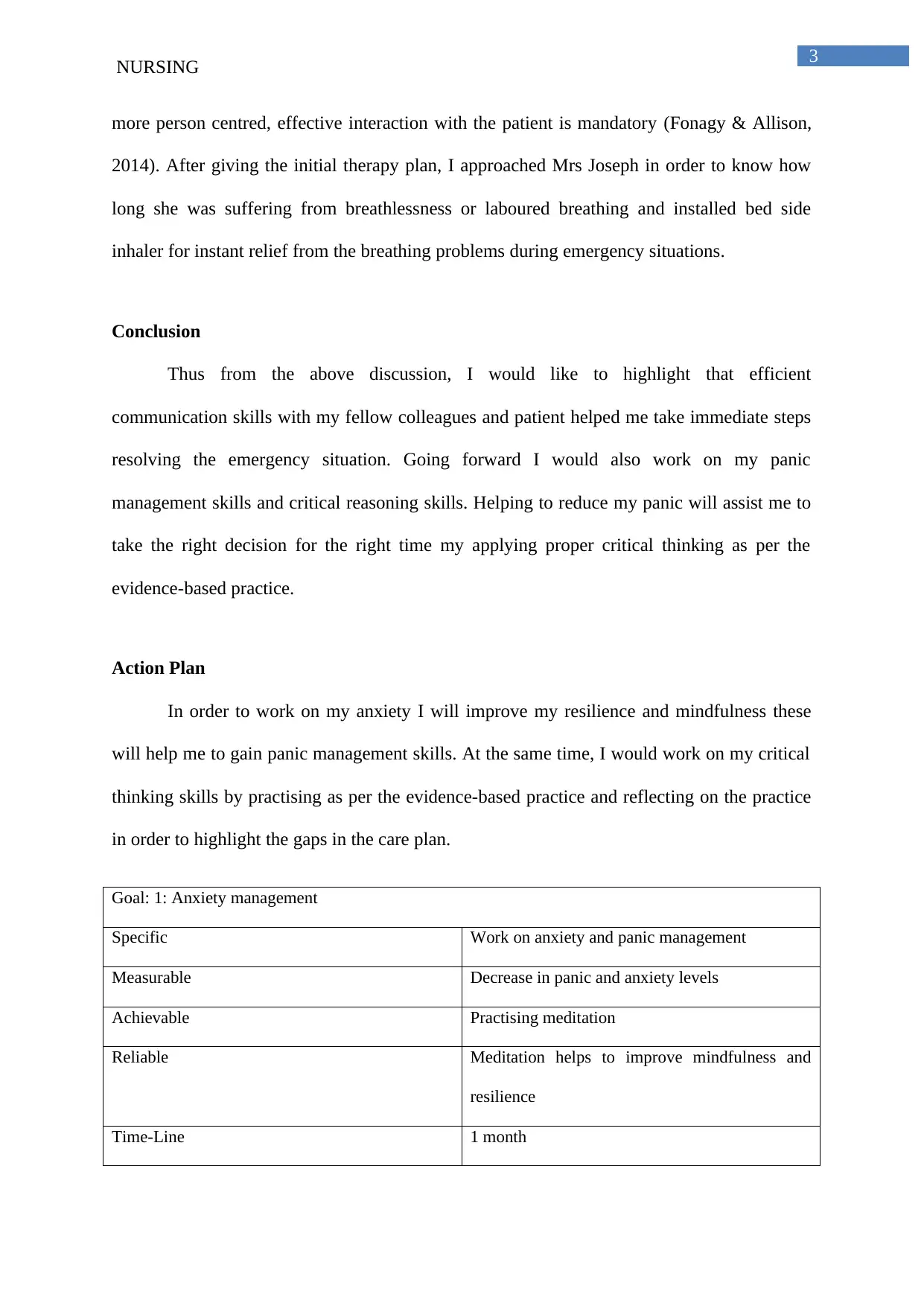
3
NURSING
more person centred, effective interaction with the patient is mandatory (Fonagy & Allison,
2014). After giving the initial therapy plan, I approached Mrs Joseph in order to know how
long she was suffering from breathlessness or laboured breathing and installed bed side
inhaler for instant relief from the breathing problems during emergency situations.
Conclusion
Thus from the above discussion, I would like to highlight that efficient
communication skills with my fellow colleagues and patient helped me take immediate steps
resolving the emergency situation. Going forward I would also work on my panic
management skills and critical reasoning skills. Helping to reduce my panic will assist me to
take the right decision for the right time my applying proper critical thinking as per the
evidence-based practice.
Action Plan
In order to work on my anxiety I will improve my resilience and mindfulness these
will help me to gain panic management skills. At the same time, I would work on my critical
thinking skills by practising as per the evidence-based practice and reflecting on the practice
in order to highlight the gaps in the care plan.
Goal: 1: Anxiety management
Specific Work on anxiety and panic management
Measurable Decrease in panic and anxiety levels
Achievable Practising meditation
Reliable Meditation helps to improve mindfulness and
resilience
Time-Line 1 month
NURSING
more person centred, effective interaction with the patient is mandatory (Fonagy & Allison,
2014). After giving the initial therapy plan, I approached Mrs Joseph in order to know how
long she was suffering from breathlessness or laboured breathing and installed bed side
inhaler for instant relief from the breathing problems during emergency situations.
Conclusion
Thus from the above discussion, I would like to highlight that efficient
communication skills with my fellow colleagues and patient helped me take immediate steps
resolving the emergency situation. Going forward I would also work on my panic
management skills and critical reasoning skills. Helping to reduce my panic will assist me to
take the right decision for the right time my applying proper critical thinking as per the
evidence-based practice.
Action Plan
In order to work on my anxiety I will improve my resilience and mindfulness these
will help me to gain panic management skills. At the same time, I would work on my critical
thinking skills by practising as per the evidence-based practice and reflecting on the practice
in order to highlight the gaps in the care plan.
Goal: 1: Anxiety management
Specific Work on anxiety and panic management
Measurable Decrease in panic and anxiety levels
Achievable Practising meditation
Reliable Meditation helps to improve mindfulness and
resilience
Time-Line 1 month
Secure Best Marks with AI Grader
Need help grading? Try our AI Grader for instant feedback on your assignments.
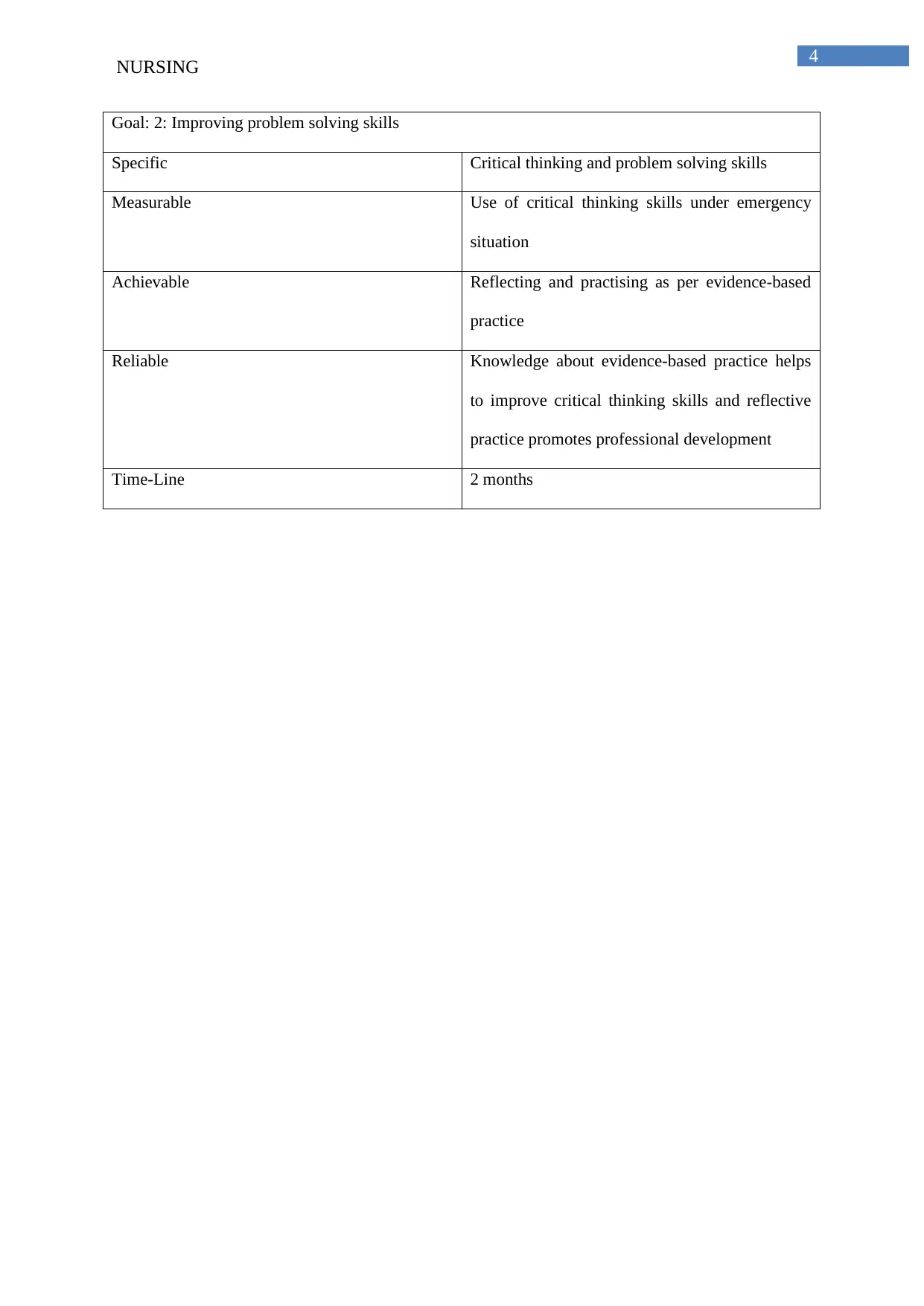
4
NURSING
Goal: 2: Improving problem solving skills
Specific Critical thinking and problem solving skills
Measurable Use of critical thinking skills under emergency
situation
Achievable Reflecting and practising as per evidence-based
practice
Reliable Knowledge about evidence-based practice helps
to improve critical thinking skills and reflective
practice promotes professional development
Time-Line 2 months
NURSING
Goal: 2: Improving problem solving skills
Specific Critical thinking and problem solving skills
Measurable Use of critical thinking skills under emergency
situation
Achievable Reflecting and practising as per evidence-based
practice
Reliable Knowledge about evidence-based practice helps
to improve critical thinking skills and reflective
practice promotes professional development
Time-Line 2 months
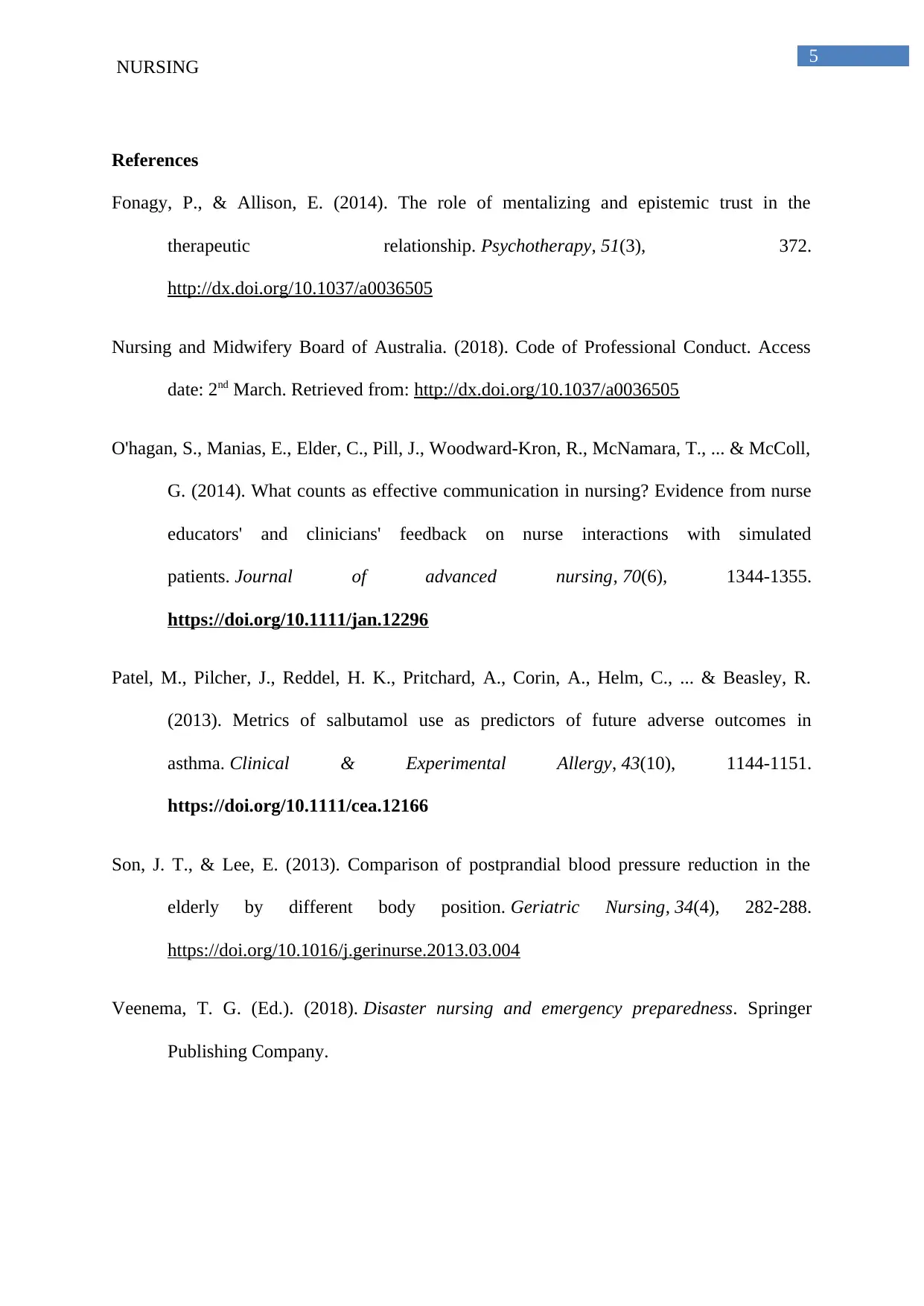
5
NURSING
References
Fonagy, P., & Allison, E. (2014). The role of mentalizing and epistemic trust in the
therapeutic relationship. Psychotherapy, 51(3), 372.
http://dx.doi.org/10.1037/a0036505
Nursing and Midwifery Board of Australia. (2018). Code of Professional Conduct. Access
date: 2nd March. Retrieved from: http://dx.doi.org/10.1037/a0036505
O'hagan, S., Manias, E., Elder, C., Pill, J., Woodward‐Kron, R., McNamara, T., ... & McColl,
G. (2014). What counts as effective communication in nursing? Evidence from nurse
educators' and clinicians' feedback on nurse interactions with simulated
patients. Journal of advanced nursing, 70(6), 1344-1355.
https://doi.org/10.1111/jan.12296
Patel, M., Pilcher, J., Reddel, H. K., Pritchard, A., Corin, A., Helm, C., ... & Beasley, R.
(2013). Metrics of salbutamol use as predictors of future adverse outcomes in
asthma. Clinical & Experimental Allergy, 43(10), 1144-1151.
https://doi.org/10.1111/cea.12166
Son, J. T., & Lee, E. (2013). Comparison of postprandial blood pressure reduction in the
elderly by different body position. Geriatric Nursing, 34(4), 282-288.
https://doi.org/10.1016/j.gerinurse.2013.03.004
Veenema, T. G. (Ed.). (2018). Disaster nursing and emergency preparedness. Springer
Publishing Company.
NURSING
References
Fonagy, P., & Allison, E. (2014). The role of mentalizing and epistemic trust in the
therapeutic relationship. Psychotherapy, 51(3), 372.
http://dx.doi.org/10.1037/a0036505
Nursing and Midwifery Board of Australia. (2018). Code of Professional Conduct. Access
date: 2nd March. Retrieved from: http://dx.doi.org/10.1037/a0036505
O'hagan, S., Manias, E., Elder, C., Pill, J., Woodward‐Kron, R., McNamara, T., ... & McColl,
G. (2014). What counts as effective communication in nursing? Evidence from nurse
educators' and clinicians' feedback on nurse interactions with simulated
patients. Journal of advanced nursing, 70(6), 1344-1355.
https://doi.org/10.1111/jan.12296
Patel, M., Pilcher, J., Reddel, H. K., Pritchard, A., Corin, A., Helm, C., ... & Beasley, R.
(2013). Metrics of salbutamol use as predictors of future adverse outcomes in
asthma. Clinical & Experimental Allergy, 43(10), 1144-1151.
https://doi.org/10.1111/cea.12166
Son, J. T., & Lee, E. (2013). Comparison of postprandial blood pressure reduction in the
elderly by different body position. Geriatric Nursing, 34(4), 282-288.
https://doi.org/10.1016/j.gerinurse.2013.03.004
Veenema, T. G. (Ed.). (2018). Disaster nursing and emergency preparedness. Springer
Publishing Company.
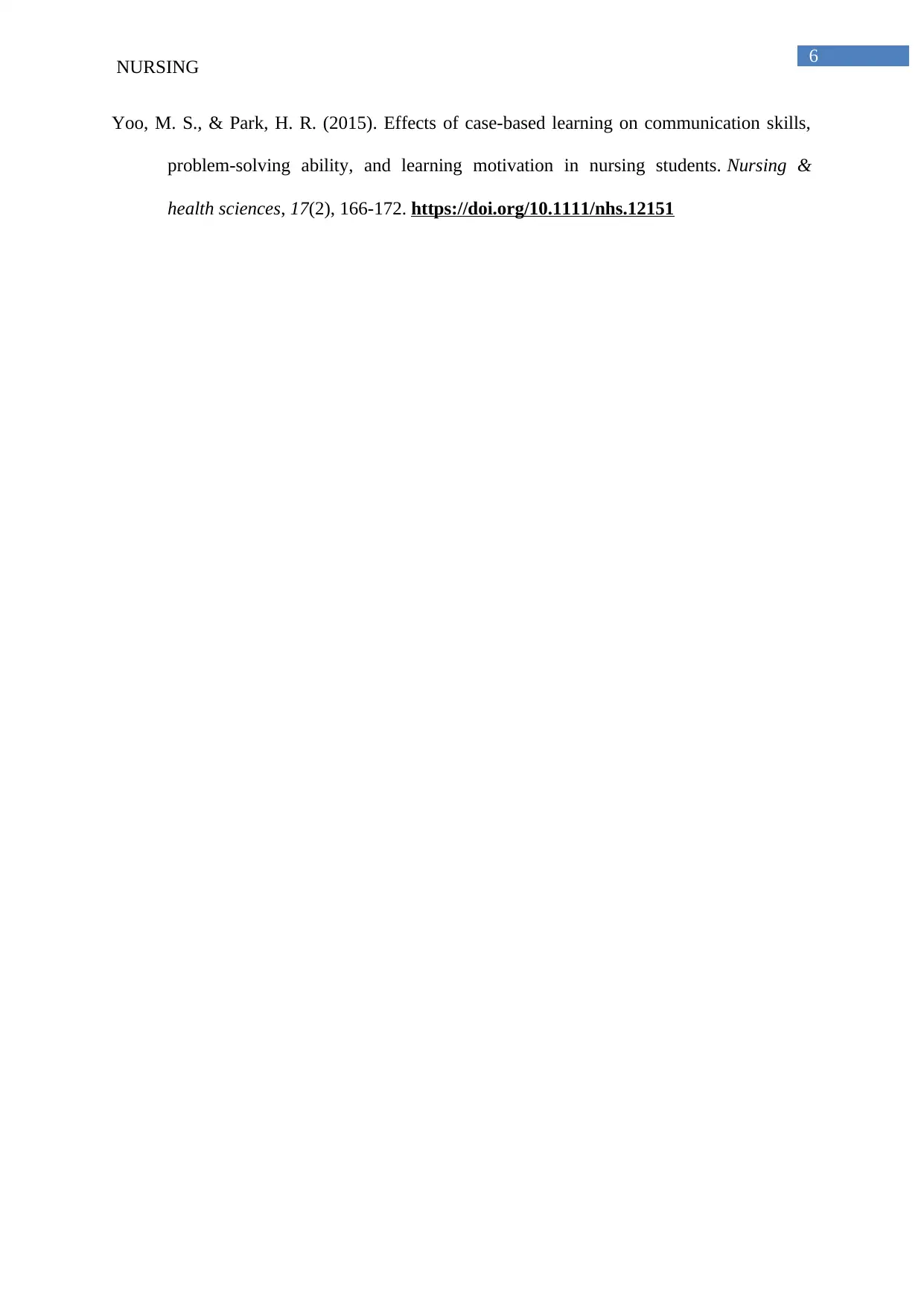
6
NURSING
Yoo, M. S., & Park, H. R. (2015). Effects of case‐based learning on communication skills,
problem‐solving ability, and learning motivation in nursing students. Nursing &
health sciences, 17(2), 166-172. https://doi.org/10.1111/nhs.12151
NURSING
Yoo, M. S., & Park, H. R. (2015). Effects of case‐based learning on communication skills,
problem‐solving ability, and learning motivation in nursing students. Nursing &
health sciences, 17(2), 166-172. https://doi.org/10.1111/nhs.12151
1 out of 7
Your All-in-One AI-Powered Toolkit for Academic Success.
+13062052269
info@desklib.com
Available 24*7 on WhatsApp / Email
![[object Object]](/_next/static/media/star-bottom.7253800d.svg)
Unlock your academic potential
© 2024 | Zucol Services PVT LTD | All rights reserved.



